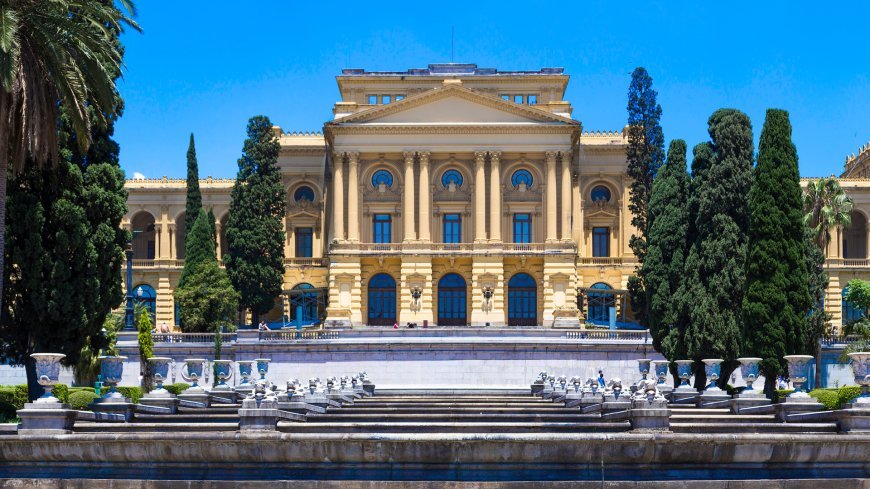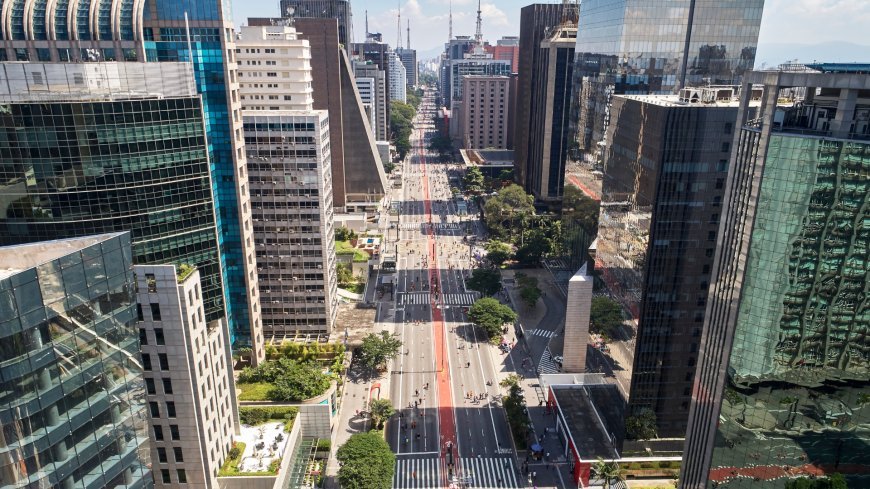Top Attractions in São Paulo, Brazil
"Discover São Paulo's top attractions: a blend of vibrant culture, historic landmarks, and dynamic urban experiences."
1. Mercado Municipal de São Paulo

"Mercado Municipal de São Paulo, also known as Mercadão, is a historic market located in São Paulo, Brazil. Renowned for its vibrant atmosphere and diverse array of fresh produce, spices, meats, and gourmet delicacies, it's a beloved destination for locals and tourists alike. The market's stunning architecture, featuring stained glass windows and a vast central hall, adds to its charm and allure, making it a must-visit cultural landmark in the heart of the city."
2. Teatro Municipal de São Paulo

The Teatro Municipal de São Paulo, or Municipal Theatre of São Paulo, stands as a cultural gem in the heart of Brazil's largest city. Completed in 1911, this majestic building showcases stunning architecture influenced by the French Renaissance style, featuring intricate sculptures, elegant columns, and a grandiose dome.
Beyond its architectural splendor, the theater is renowned for its rich cultural heritage and world-class performances. It has hosted an array of operas, ballets, concerts, and theatrical productions, attracting both local talents and international artists.
Inside, the opulent interior further enhances the experience, with lavish décor, ornate furnishings, and exquisite detailing throughout its halls and auditoriums.
The Teatro Municipal de São Paulo serves not only as a venue for entertainment but also as a symbol of the city's enduring dedication to the arts and culture, captivating audiences and inspiring creativity for over a century.
3. Catedral Metropolitana de São Paulo (da Sé)

The Catedral Metropolitana de São Paulo, commonly known as Catedral da Sé, stands as an iconic symbol of faith and architectural grandeur in São Paulo, Brazil. This magnificent cathedral, situated in the heart of the city, is a testament to the enduring legacy of religious devotion and cultural heritage.
Constructed over several decades and completed in 1954, the Catedral da Sé boasts an impressive Neo-Gothic design, characterized by its towering spires, intricate façade adorned with sculptures, and vast interior spaces. Its central nave reaches an impressive height, creating a sense of awe and reverence for visitors.
Stepping inside, one is immediately struck by the cathedral's grandeur and solemnity. Stained glass windows illuminate the interior with vibrant hues, while ornate altars, sculptures, and religious artwork adorn the sacred space, inviting contemplation and prayer.
Beyond its architectural and religious significance, the Catedral da Sé serves as a focal point for cultural and community events in São Paulo. It hosts religious ceremonies, concerts, and other gatherings that bring together people from all walks of life, fostering a sense of unity and belonging.
As one of the largest cathedrals in Brazil and a prominent landmark in São Paulo, the Catedral Metropolitana de São Paulo stands as a beacon of spirituality, history, and cultural heritage, welcoming visitors to experience its timeless beauty and significance.
4. Museu do Ipiranga - USP

The Museu do Ipiranga, affiliated with the University of São Paulo (USP), is a prestigious cultural institution located in São Paulo, Brazil. Situated within the beautiful Parque da Independência, the museum holds a prominent place in Brazilian history and heritage.
Established in 1895, the Museu do Ipiranga is dedicated to preserving and showcasing the rich cultural, artistic, and historical heritage of Brazil. Its primary focus is on the nation's independence and the events surrounding it, making it a significant educational resource for both locals and visitors.
The museum's collection features a diverse range of artifacts, documents, artworks, and historical objects that offer insights into Brazil's past, from pre-colonial times to the present day. Visitors can explore exhibitions highlighting key moments in Brazilian history, such as the declaration of independence in 1822 and the country's socio-cultural evolution over the centuries.
One of the most iconic features of the Museu do Ipiranga is its stunning neoclassical building, designed by Italian architect Tommaso Gaudenzio Bezzi. The architectural masterpiece is renowned for its grandiose façade, elegant interiors, and majestic central dome, which serves as a symbol of Brazil's cultural and architectural heritage.
In addition to its permanent exhibitions, the museum also hosts temporary displays, educational programs, and cultural events that further enrich the visitor experience. These initiatives aim to engage audiences of all ages and backgrounds, fostering a deeper appreciation for Brazilian history and culture.
As a vital cultural institution in São Paulo, the Museu do Ipiranga plays a crucial role in preserving and promoting Brazil's heritage for future generations, ensuring that its rich legacy continues to inspire and educate for years to come.
5. Parque Ibirapuera

Parque Ibirapuera stands as a verdant oasis amidst the bustling metropolis of São Paulo, Brazil. This sprawling urban park, often referred to as the "Central Park of São Paulo," is a beloved recreational and cultural hub that offers respite from the city's concrete jungle.
Designed by landscape architect Roberto Burle Marx and architect Oscar Niemeyer, Parque Ibirapuera was inaugurated in 1954 to commemorate São Paulo's 400th anniversary. Since then, it has become an integral part of the city's identity, attracting millions of visitors each year with its lush greenery, tranquil lakes, and wide-open spaces.
The park's extensive grounds encompass a variety of attractions and amenities, catering to visitors of all ages and interests. Nature lovers can wander along scenic walking paths, cycle through tree-lined avenues, or relax amidst the park's picturesque landscapes. Boating on the park's serene lakes provides a peaceful escape from the urban hustle and bustle.
Parque Ibirapuera is not only a haven for outdoor enthusiasts but also a vibrant cultural destination. It is home to several iconic architectural landmarks, including the Museu de Arte Moderna (Museum of Modern Art), designed by Lina Bo Bardi, and the Oca, a futuristic exhibition space created by Oscar Niemeyer. These institutions host rotating exhibitions, art installations, and cultural events that showcase the best of contemporary art and design.
Additionally, the park features numerous sports facilities, playgrounds, and picnic areas, making it a popular destination for families and recreation enthusiasts. Joggers and fitness enthusiasts can be seen exercising along the park's trails and open spaces, while yoga classes and outdoor concerts offer opportunities for relaxation and entertainment.
Parque Ibirapuera is not just a park; it is a vibrant reflection of São Paulo's dynamism, diversity, and cultural richness. Whether visitors come to unwind amidst nature, explore its architectural marvels, or simply soak in the lively atmosphere, the park never fails to captivate and inspire all who venture within its green embrace.
6. Avenida Paulista

Avenida Paulista stands as the vibrant artery of São Paulo, Brazil, pulsating with energy, diversity, and dynamism. This iconic thoroughfare is not just a street but a cultural, economic, and social epicenter that epitomizes the spirit of Brazil's largest city.
Stretching for approximately 2.8 kilometers (1.7 miles) through the heart of São Paulo, Avenida Paulista is a bustling boulevard lined with skyscrapers, corporate headquarters, luxury boutiques, art galleries, theaters, and an eclectic array of restaurants and cafes. Its towering buildings and bustling sidewalks create an urban jungle where commerce, culture, and creativity converge.
Avenida Paulista is more than just a commercial hub; it is also a melting pot of cultures and identities. On any given day, the avenue teems with people from all walks of life: business executives hurrying to meetings, students studying in cafes, artists showcasing their work on the sidewalks, and tourists soaking in the lively atmosphere. The avenue's inclusive vibe and cosmopolitan flair make it a symbol of São Paulo's cultural diversity and openness.
In addition to its commercial and cultural significance, Avenida Paulista is also a focal point for leisure and entertainment. The avenue hosts a variety of events and activities throughout the year, including art fairs, music festivals, street performances, and parades. Its wide sidewalks and pedestrian-friendly design invite visitors to stroll, shop, dine, and immerse themselves in the vibrant street life.
One of the most iconic landmarks along Avenida Paulista is the São Paulo Museum of Art (MASP), a striking modernist building designed by architect Lina Bo Bardi. The museum's distinctive architecture and world-class art collection draw visitors from around the globe, further enriching the avenue's cultural landscape.
Avenida Paulista is not just a street; it is a symbol of São Paulo's resilience, creativity, and relentless pursuit of progress. It embodies the city's spirit of innovation and inclusivity, serving as a testament to the dynamic nature of urban life in Brazil's bustling metropolis.
7. Liberdade neighborhood in São Paulo

The Liberdade neighborhood in São Paulo stands as a vibrant and culturally rich enclave that reflects the city's diverse heritage and dynamic spirit. Initially settled by Japanese immigrants in the early 20th century, Liberdade has evolved into a bustling hub that celebrates a blend of Japanese, Chinese, and other Asian cultures.
Wandering through Liberdade's streets, visitors are greeted by a tapestry of sights, sounds, and flavors that transport them to the streets of Tokyo or Shanghai. The neighborhood is renowned for its bustling markets, ornate pagodas, and traditional tea houses, creating a unique blend of old-world charm and modern dynamism.
One of the most iconic features of Liberdade is its bustling street market, which takes place every Sunday. Vendors line the streets, selling everything from fresh produce and exotic spices to traditional crafts and souvenirs. The market is a sensory delight, filled with the aroma of street food stalls and the vibrant colors of lanterns and paper parasols.
Liberdade is also home to a plethora of authentic Asian restaurants, offering a tantalizing array of cuisine from Japan, China, Korea, and beyond. Whether craving sushi, ramen, dim sum, or bubble tea, visitors can find an abundance of options to satisfy their culinary cravings.
In addition to its culinary delights, Liberdade boasts a rich cultural scene, with events and festivals celebrating Asian heritage throughout the year. The neighborhood comes alive during the annual New Year celebrations, with dragon dances, traditional music performances, and fireworks lighting up the streets.
Beyond its cultural attractions, Liberdade is also a thriving residential and commercial district, with bustling shopping streets, lively nightlife venues, and a vibrant community spirit. Its colorful street art, charming alleyways, and historic landmarks add to the neighborhood's allure, making it a must-visit destination for locals and tourists alike.
Liberdade is more than just a neighborhood; it is a living testament to São Paulo's multicultural identity and the enduring legacy of its immigrant communities. With its rich history, diverse culture, and lively atmosphere, Liberdade continues to captivate and inspire all who venture into its vibrant streets.

















